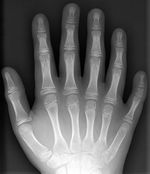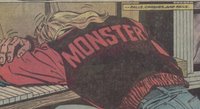 One of my favorite ways to procrastinate is to use the power and breadth of the Internet to dredge up ephemera. (As if you hadn't noticed.) But I have to say, the Internet is letting me down on at least one search: pianists with more than ten fingers. I've been looking into every dusty corner of this worldwide web for any evidence of such a phenomenon. And I'm more than a little surprised to come up empty-handed.
One of my favorite ways to procrastinate is to use the power and breadth of the Internet to dredge up ephemera. (As if you hadn't noticed.) But I have to say, the Internet is letting me down on at least one search: pianists with more than ten fingers. I've been looking into every dusty corner of this worldwide web for any evidence of such a phenomenon. And I'm more than a little surprised to come up empty-handed. Mind you, there's no shortage of fictional extra digits out there. There's the 12-fingered fellow from the movie Gattaca. There's this journalistically suspect 14-fingered prodigy. The Marvel comic The New Defenders (an X-Men spin-off) briefly featured a 12-fingered mutant pianist named—wait for it—Adrian Leverkuhn Castorp (why they didn't just throw "Krull" and "Aschenbach" in there while they were at it, I'll never know). On a more serious note, there's Ben Fountain's haunting short story "Fantasy for Eleven Fingers," which features two eponymously polydactyl characters.
Mind you, there's no shortage of fictional extra digits out there. There's the 12-fingered fellow from the movie Gattaca. There's this journalistically suspect 14-fingered prodigy. The Marvel comic The New Defenders (an X-Men spin-off) briefly featured a 12-fingered mutant pianist named—wait for it—Adrian Leverkuhn Castorp (why they didn't just throw "Krull" and "Aschenbach" in there while they were at it, I'll never know). On a more serious note, there's Ben Fountain's haunting short story "Fantasy for Eleven Fingers," which features two eponymously polydactyl characters.But nary a real pianist to be had. I found a guitarist (the marvelous "Hound Dog" Taylor), and there's at least a couple of references to violinist Giuseppe Tartini's alleged supernumerary appendages (his Wikipedia entry mentions the possibility).
Again, no pianists. Why not? Polydactyly is not that uncommon: most web sources (like this one) estimate that it occurs in 1 out of every 500 children. Now, most of those extra fingers are non-functional, lacking adequate bone and muscle structure, but not always. Given those odds, I would expect at least a handful of examples in the five centuries or so of western keyboard music. So what's going on?
There's the very real possibility that most poor polydactyl children had their extra fingers hacked off before they had a chance to crack open their Hanon. Today, the standard medical recommendation still seems to be surgical removal, even in cases of functional digits. You can probably imagine how much more pressure there would have been back in the day, when people could still get irrationally worked up about witchcraft and satanic possession. (Yes, "back in the day." So I'm an optimist.)
But more than that, while most people would assume that hands that go to "11" would be a boon in playing the piano, I'm not so sure. The piano repertoire is specifically designed for ten fingers. It's comfortable for ten fingers. When it's not comfortable, there's centuries of tradition on how to get around the trouble spots—using ten fingers. This all goes back to something I've frequently pondered—the fact that human physicality is so intricately worked into the fabric of the music we have that we don't even think about it. Fiction writers might think that eleven or twelve fingers would make piano technique easier (and it sure makes for a great metaphor), but seeing as how that technique is nothing more that the collective wisdom of countless boringly ten-fingered pianists, it’s just as possible that the extra digits might make playing our idiosyncratically engineered piano terribly awkward.
Actually, when I said I couldn't find a single pianist? I lied: I did track down one. Unfortunately, I don’t know his name. He was a German-born machinist living in Boston sometime in the 19th century.
[He had] one index finger, two middle fingers, two ring fingers, and two pinkies. … [T]his rare genetic malformation is called a mirror hand. The lower arm beneath the elbow is also symmetric. Whereas a normal lower arm is composed of two bones, a radius and an ulna, this lower arm has two ulnae and no radius. While this impeded the turning motion of the man’s lower arm, he did not let it stop him from enjoying his favorite hobby—piano playing!That’s from the Warren Anatomical Museum at Harvard University. That’s right, they still have this man’s hand. And heck, yeah, there’s a picture. (WARNING: above link contains image that may seriously gross you out, unless you’re an 11-year-old boy, in which case it’s the coolest thing you’ve ever seen.)
Still, I’m convinced he can’t be the only one out there. Anybody else? Just stop playing for a minute and raise your hand. I can count.

2 comments:
I think I must be an 11-year-old boy.
I've just read about an even more amazing case of mirror hand. Sadly, I doubt that it was ever possible for this person to play the piano.
Post a Comment